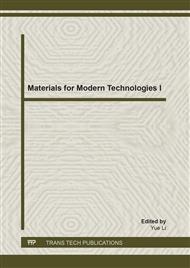p.111
p.119
p.125
p.131
p.137
p.143
p.149
p.155
p.163
Dry Sliding Wear Resistance of the In Situ Al2O3/Al-Si Composites Fabricated in Al-SiO2 by Reaction Hot Pressing
Abstract:
The dry sliding characteristics of three in situ Al2O3/Al-Si composites fabricated with volume fraction of 10, 20 and 30 vol.% were investigated. The effect of sliding parameters on the wear properties was investigated. As the sliding velocity increases the wear loss decreases systematically. When the volume fraction increased to 20 vol.%, an improvement of wear resistance was obtained. However, when the volume fraction was 30 vol.%, a further decrease of wear resistance was observed. In case of low volume fraction (10 vol.%), an extensive plastic deformation by plowing out the ductile Al matrix along with narrow grooves was observed. As the volume fraction increased to 20 vol.%, the abrasive wear by micro grooving is dominant as well as the low load is used. Whereas, when the volume fraction increased to 30 vol.%, besides the effect of large pores, the embedded Al2O3 in the massive Si blocks formed a weaker interface thereby behaving as source of crakes initiation and propagation. As result, fracture, micro-cutting and delaminating are observed as dominant abrasive wear mechanisms
Info:
Periodical:
Pages:
155-161
Citation:
Online since:
May 2015
Authors:
Keywords:
Price:
Сopyright:
© 2015 Trans Tech Publications Ltd. All Rights Reserved
Share:
Citation:


